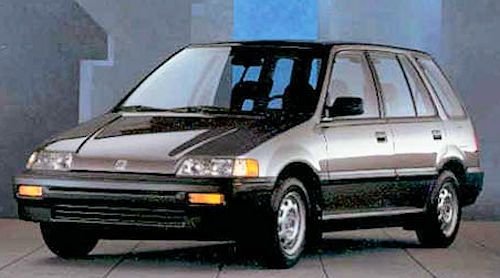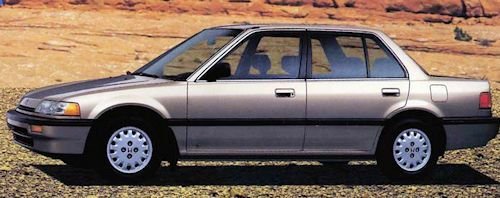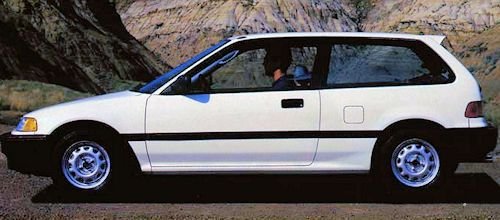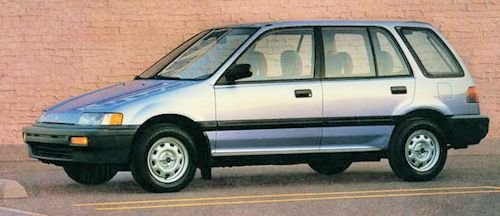Honda Civic Fourth generation
 |
|
| Manufacturer | Honda |
|---|---|
| Production | 1987-1991 |
| Assembly | Suzuka, Japan Swindon, England East Liberty, Ohio, USA Alliston, Ontario, Canada Hsinchu, Taiwan South Africa Nelson, New Zealand |
| Predecessor | Honda Civic (third generation) |
| Successor | Honda Civic (fifth generation) |
| Body style | 3-door hatchback 3-door coupe (CRX) 4-door sedan 5-door station wagon (Shuttle) |
| Layout | Front engine, front-wheel drive / Four-wheel drive |
| Engine | 1.3 L D13B I4 1.4 L D14A I4 1.5 L D15B1 I4 1.5 L D15B2 I4 1.6 L D16A6 I4 1.6 L ZC SOHC I4 1.6 L B16A DOHC I4 1.6 L D16A9 I4 |
| Transmission | 4-speed manual 5-speed manual 6-speed manual 4-speed automatic |
| Wheelbase | 98.4 in (2,499 mm) |
| Length | 156.1 in (3,965 mm) (hatchback) 166.5 in (4,229 mm) (sedan) 161.7 in (4,107 mm) (wagon) |
| Width | 65.6 in (1,666 mm) (hatchback) 65.9 in (1,674 mm) (sedan) 66.1 in (1,679 mm) |
| Height | 52.4 in (1,331 mm) (hatchback) 53.5 in (1,359 mm) (sedan) 56.1 in (1,425 mm) (FWD Wagon) 56.9 in (1,445 mm) (4WD Wagon) |
| Related | Acura Integra Honda CR-X Honda Ballade Honda Concerto Honda Integra Rover 200 (R8) Rover 400 (R8) |
Japan
The base model of the fourth generation Civic had a 1.2 L SOHC, this single carbureted engine was not available for the Japanese and American markets. In Japan the base version received a 1.3 L SOHC single carbureted engine, thus equipped it was called either 23L or 23U.
The 1.5 L SOHC engine came in a wide variety of models, dual-point injection, single carbureted and dual carbureted. Those engines were available in the Japanese-market 25X and 25XT. The Japanese version of the sporting Si, initially the top version, featured a (ZC) D16A8/A9 1.6 L 16V DOHC engine.
But there was more to come, and in late 1989 the new top model of the hatchback was the new SiR, fitted with the 1.6-litre, 160 PS (118 kW; 158 hp) at 7,600 rpm "B16A" DOHC VTEC engine. This, the first B engine, marked the introduction of Honda's variable valve timing and electronic lift control technology, or VTEC. By providing two different camshaft profiles—one for fuel economy, one for performance—the VTEC engines set a high-revving, naturally aspirated precedent for future performance variants of the Honda Civic.With its light weight, independent suspension and powerful engine, the car was well-received globally, receiving “Golden Steering Wheel Award” from the German newspaper Bild am Sonntag, and ranking first in France’s l’Automobile magazine 1989 survey on car quality and reliability. The European model, badged as a "1.6i-VT", used a slightly less powerful B16A1 engine, which had an 8,200 rpm redline and made 150 hp (112 kW), although it made the same 111 lbf·ft (150 N·m) of torque as the Japanese market B16. In Japan, automatic-equipped SiR Civics also received the lower-powered engine.
Performance
- 1.3L Litre Performance
- 55kW (74hp) 75PSI at 6300rpm
- 41KWL (54.9hp/L) [55.8PS/L]; 102Nm (75.21bft) at 3100rpm
- leaded regular grade.
- Japanese Version JIS nett:
- 60kW (80.4hp) [82PS] at 6300rpm
- 44.7kW/L (59.9hp,L) 61.1PS/L1; 104Nm (176.71bft) at 3500rpm.
- 1.6 Litre Performance
- 79kW (106hp) 107 PS at 6300rpm
- 81kW (109hp) 110 PS at 6000rpm; 135Nm (99.61bft) at 5000rpm.
- European version
- (DIN): 85kW (114hp) 116 PS at 6300rpm; 141Nm (1041bft) at 5300rpm.
- Japanese version
- 88kW (118hp) [120PSl at 6300rpm 55.3kW/L (74.1hp/L) [75.51); 142Nm (104.71bft) at 5500rpm.
- Max speed Saloon/Sedan 118mph/190kmh, Shuttle 4WD 107mph/172kmh
- acceleration 0 — 62mph/100kmh (80kW) 8.9secs
- power to weight ratio from 9.7/kW (7.1kg/PS)
- 1.6 Litre DOHC Performance
- 96kW (128hp) 130PSJ at 6800rpm, 60.4kW/L (80.9hp/L) [81.8PS/L1, 143Nm (105.51bft) at 5700rpm.
- With Catalyst (DIN): 88kW (118hp) 120PSJ at 6800rpm; 135Nm (99.61bft) at 5700rpm
- Japanese version (JIS nett):96kW (128hp) [130PS]; 144Nm (106.21bft).
- Max speed CRX 132mph/212kmh speed at 1000rpm in 5th gear 19.3mph/31.0 kmh
- acceleration 0- 62mph/100kmh 7.5secs
- power to weight ratio from 9.2kgkW (6.8kg/PS)
The wagon, known in Japan as the Civic Shuttle, continued but the commercial-use "Shuttle Pro" was replaced by a dedicated commercial delivery van called the Honda Partner starting with model year 1996.

North America
All United States vehicles were fuel injected.
In 1989 the Civic had a light facelift. Some things that changed were the front bumper design, the front corner lights no longer had the two screws on the outside, the gauge cluster cover shape slightly changed, tail light units design changed, side moldings became thinner, and most American Civics received automatic seat belts due to changes in federal highway safety law. The sedan and wagon featured powered automatic shoulder belts that retracted from the b-pillar to a position halfway down the a-pillar when the door was open, while the hatchback received a standard style shoulder and lap belt mechanism that was attached to the door and was intended to remain buckled at all times. While this setup did satisfy the federal regulations, the front doors had to be opened very wide to allow access between the belt and the seat. Many Civic owners used the door mounted belts just as they would pillar mounted belts, buckling and unbuckling as necessary.

Models Available
STD
The base model with the lowest price and lowest standard (vinyl seats) interior, instrumentation, engine output and transmission. It was only available as a Hatchback. Engine was D15B1 16V SOHC, with dual port throttle body injection, 70 hp (52.2 kW) with restrictor on the tandem valve, and catalytic converter integrated into the exhaust manifold. Manual transmissions were 4-speed with cable operated clutch (5-speed in Canada). Automatic 4-speed transmission was also available.
DX
Available as Hatchback, Sedan and Wagon, this had cloth seats, optional power steering, optional rear wash/wiper, optional clock, optional passenger door mirror and optional wheel covers. Engines were D15B2 16V SOHC with slightly higher output 92 hp (68.6 kW) due to an improved profile on the inlet side of the Single Overhead Cam and unrestricted tandem valve. Manual transmissions came as 5-speed with cable operated clutch. Automatic transmission was available as an option.
LX
Available only as a Sedan, this had a higher level interior with tachometer instrumentation, electric windows, electric door locks, electric door mirrors, cruise control, clock and wheel covers as standard. Engines were D15B2 16V SOHC, same as the DX, with 5-speed cable clutch transmission. 4- speed automatic transmission was optional.
EX
Available only as a Sedan for 1990 and 1991 model years, this was the top of the Civic line with the LX features,and a D16A6 16V SOHC engine with 4-point injection. It also had upgraded brakes on the front with 10.3" disks vs. the 9.5" on the STD, DX, LX and SI models. The 1991 had a higher geared steering rack - 3.1 turns lock to lock vs 4 for other and prior models.
SI
Initially, the Civic Si hatchback was absent from the lineup, with only the CRX Si offered for the 1988 model year. That changed, however, for 1989, and the Civic Si hatchback was reintroduced, along with a 3-hp upgrade for the D16 engine across all Si trims (making 108 hp, 1988 CR-X Si 105 hp). This was the sportiest US market Civic, only available as a hatchback. The engine fitted was the D16A6 16-valve SOHC with 4-point injection and output of 108 hp (81 kW). It weighed in at 2,286 lb (1,037 kg), achieving a factory 0–60 mph of 8.1 seconds; and a quarter-mile time of 16.2 at 82 mph (132 km/h).
The main standard features of the Si trim were the power sun roof/moon roof, tachometer, passenger door mirror, color matched bumpers, dash clock, larger exhaust, front and rear anti-roll bars, 14" steel wheels with covers, and slightly deeper bucket sport seats. There was no power steering and no automatic transmission available (except in Canada). Additional options were air conditioning and fog lights, as well as the different Honda Genuine Accessory alloy wheels.[4] In other markets, a more powerful D16A8 and D16A9 engines were used instead, which made 122 hp (91 kW) and 132 hp (98 kW) respectively.
Compared to the previous generation, the Civic Si saw an improvement in handling, in part due to the double-wishbone suspension at all four corners and lower wind drag due to the sleeker body shape. As with all other trims, the Civic Si received a slight visual upgrade in 1990, featuring revised bumpers and tail lights.
Due to the difference in engine output and modification potential between the American and JDM models, the second-generation Si sparked a popular trend of engine swapping, where tuners would replace the D-series power plant (whose limiting factor for power were its weak connecting rods) with the stronger B-series motor.
Wagon

This was available as FWD and RealTime4WD. The RT4WD versions featured the MPFI D16A6 engine paired with either a 6-speed manual (with a super-low gear left of first) or a 4-speed automatic transmission. The FWD versions featured the DPFI D15B2 engine paired with a 5-speed manual or 4-speed automatic transmission. RT4WD wagons had white steel wheels with matching center caps. This bodystyle remained in production until February 21, 1996, when it was replaced by the Honda Orthia and professional use Honda Partner, sold only in Japan.
Europe
For Europe the base model was the 1.3 Luxe with engine was the 1.4 L which was not available in the USA and Japan.Next was a 1.4 L SOHC I4 dual carbureted engine that was available only in 1988 and 1989; 1.5i GL and GLX models followed in 1990.
The European 1.6i GT and 1.6i-16 (depends on country) had a ZC like 1.6 L DOHC engine and produced 124 hp (D16Z5) or 130 hp (D16A9). In Europe the SiR was called 1.6i-VT and had a similar B16A1 engine. These top models were equipped with the VTEC system.
Technical
-
Honda Civic 4th gen Technical details and specifications (1987-1991)
DIMENSIONS AND WEIGHT:
Saloon/Sedan; 3-door, 5—seater; kerbweight (DIN) 800kg.
Sallon and sedan; 4-door, 5—seater; kerbweight (DIN) 870kg.
Estate/Station Wagon;, 5—seater; kerbweight (DIN) 900kg.
Coupe; 3-door, 2 + 2—seater; kerbweight (DIN) 830kg.
1.6 Litre DOHC Body, Weight: Saloon/Sedan 3-door — 910kg. Coupe CRX 890 — 925kg.Saloon/Sedan 3—door
wheelbase 250cm
track 145/145.5cm
turning circle 10.4m
Length 396cm
width 168cm
height 133cm.
load space 8.8cu ft (250dm3)Saloon/Sedan 4—door
wheelbase 250cm
track 145/145.5cm
turning circle 10.4m
load space 13.5cu ft
Length 423cm
width 169cm
height 136cmShuttle
Wheelbase 250cm, track 144.5/145.5cm (4WD 144/145cm).
Load space 22.9cu ft (648dm3)
length 410.5cm width 169cm
height 147cm, 4WD 151.5cmCoupe CRX:
Wheelbase 230cm
track 145/145.5cm
clearance 10.5cm,
turning circle 9.8m
Load space 6.9cu ft (196dm3)
length 375.5cm
width 167.5cm
height 127cm.CHASSIS:
type Integral body
all—round independent suspension with coil springs and adjustable shock absorbers
front upper A—arm, lower control arm and antiroll bar; rear trailing arms with upper and lower control arms
Rear antiroll bar 1.6l.BRAKES:
Servo/power amsted brakes
front ventilated discs, rear drums
mechanical handbrake on rear Wheels
Some models with four wheel disc brakes (front ventilated), Shuttle rear drums
1.6 Litre DOHC All—round disc brakes (front ventilated)STEERING:
rack and pinion steering (optional power assisted).WHEELS TYRES:
1.3 Litre
tyres 155 SR 13, (optional 165/70 SR 13)
wheel rims 4.5J optional 5J.
1.5 Litre
Tyres 165/70 SR 13 or 175/70 SR 13 (optional 185/60 SR/'HR 14),
wheel rims 5J.
1.6 Litre
tyres 175/70 SR 13, 175/65 SR 13 185/60 HR 14 or 185/65 HR 14.4WD 165 SR 13 or 175/65 SR 14
wheel rims 5J.
1.6 Litre DOHC
tyres 185/60 HR/VR 14
wheel rims 5 or 5.5J.TRANSMISSION DRIVE LINE:
Drive (to front wheels)
1.3 Litre
5—speed manual
final drive ratio 4.058 or 4.250.
Automatic, hydraulic torque converter 4—speed Planetary gear set and lock—up
final drive ratio 3.933.
Gear ratios: a) 5--speed manual: 1st 3.250; 2nd 1.894; 3rd 1.259; 4th 0.937; 5th 0771; R 3.153.
Automatic ratios Planetary gear set ratios; 1st 2.705; 2nd 1.560; 3rd 1.027; 4th 0.780; R 1.954.
1.5 Litre
Automatic, final drive ratio 3.933.
5—speed manual with range change, final drive ratio 4.428
1.6 Litre
Transmission 5—speed manual
final drive ratio 4.058/4.250.
Automatic, final drive ratio 3.933.
Sedan and Shuttle 4WD
permanent four—wheel-drive with viscous coupling.
5—speed manual with range change, final drive ratio 4.928/4.428.
Gear ratios 4WD: 1st 3.384;2nd 1.950; 3rd 1.275; 4th 0.941; 5th 0.783; R 3.000; range change 4.512.
1.6 Litre DOHC
Transmission:5—speed manual, final drive ratio 3.888, with Catalyst 4.250
Automatic, hydraulic torque converter and 4—speed Planetary gear set with lock—up, selector lever in the middle, final drive ratio 3.933.
Gear ratios: 5—speed manual; 1st 3.250; 2nd 1.944; 3rd 1.346; 4th 1.033; 5th 0.878; R 3.153.
With Catalyst; 1st 3.250; 2nd 1.894; 3rd 1.259; 4th 0.937; 5th 0.771; R 3.153.
Automatic; Planetary gear set ratios: 1st 2.705; 2nd 1.560; 3rd 1.027; 4th 0.780; R 1.954.ENGINE:
1.3L Litre
Engine data (DIN): 1.3L
4-cylinder in—line (76 x 76mm), 1343cm3
compression ratio 9.0:1
Transverse front engine, 4—valves (in V) per cylinder
1 overhead camshaft (toothed belt)
light—alloy cylinder head and block
5 bearing crankshaft
oil capacity 3.5L (3.3US qt)
downdraught two stage carb, electronic engine management
Battery 12V 35/47Ah, alternator 45-65A
cooling system capacity approx 4.4-5.0L (4.2-4.7US qt).1.5 Litre
Honda Civic Hatchback
1.5 Litre 69kW-93hp-94PS
Central/Single point Injection — 1/2 Carbs
4—cylinder in—line (75 x 84.5mm), 1493cm3;
compresion ratio 9.2:1
69kw (93hp) 94 PS/l at 6000rpm
46.2kW/L (61.9 hp/L) 63.0 PS/L 121Nm (89.21bft) at 4500rpm
unleaded regular grade.
Electronic central/single point injection (catalyst version).
2 horizontal draught constant pressure carbs or 1 down draught carb
Battery 42-60Ah
cooling system capacity 5.1L (4.8US qt)
final drive ratio 4.0581.6 Litre
Fuel Injection Not for CRX (except USA)
(75 x 90mm), 1590cm3
compression ratio 9.1:1
Engine construction:
Electronic fuel—injection PGM—FI
Battery 60Ah.
1.6 Litre DOHC
Fuel Injection Civic Si (3—door) and CRX
4—cyIinder in—line (75 x 90mm)
compression ratio 9.5:1.
unleaded regular grade.
Designated ZC. 2 overhead camshafts (toothed belt)
oil capacity 4L (3.8US qt)
electronic fuel injection PGM—FI
Battery 12V 47Ah
alternator 60A
cooling system capacity 4.5L (4.3US qt).© Motor car History
